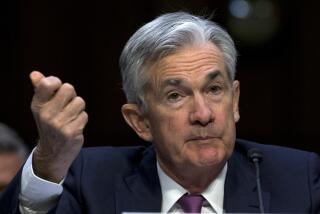Rich Man . . .
WASHINGTON — If Federal Reserve Board Chairman Alan Greenspan had Secret Service protection, he could have only one code name: Rumpelstiltskin, for the fairy-tale figure who spun straw into gold.
With the current business cycle now in its seventh year, and with the Dow Jones industrial average up 400% over a decade of Greenspan’s magic money-spinning, the Fed chairman is either going to be the most successful central banker of the 20th century or the first Fed chairman spattered by having a giant speculative bubble pop on his watch. The stakes are enormous, economically, financially, even politically.
Indeed, as the calendar advances toward May 20 and the next Fed Open Market Committee meeting, Arab sheiks, Japanese bankers and California pension-fund managers are all watching. Will Greenspan raise interest rates to curb runaway inflation in stock indexes, CEO salaries and investment-banker fees, or will he revert to the election-year permissiveness he showed in 1996?
Because Greenspan has been so successful in making the ups and downs of the U.S. money supply serve the interests of Americans who have most of the money, he has become our financial Merlin. Republican Ronald Reagan appointed him to the Fed chair in 1987; then Democrat Bill Clinton reappointed him in 1996. By then, it would have been unthinkable not to keep him. Greenspan at the Fed has become not just Mr. Monetary Magic, but Mr. Responsible Continuity. For two or three days a month, when the markets rock and the traders roll, he’s the most powerful man in the global economy.
His record has several especially notable dimensions. First, as Federal Reserve chairman, he--not the president or Congress--has managed the highly unusual U.S. business cycle of the last seven years. Wall Street economists ooh and aah just thinking about it, and the political economics are unprecedented.
For the first time anyone can remember, we have a business expansion underway that began in the administration of one party (March 1991), has lasted through another full term of the opposition party (January 1993 to January 1997) and is now bulldogging into the second term of that party.
Washington’s top politicians have been more surprised bystanders than deliberative architects. When this current business recovery began in 1991, during President George Bush’s administration, Bill Clinton scoffed--the uptick was statistical, not real. People, Clinton said, rightly saw the economy as still in recession, which continued into 1992. In 1993, with Clinton now president, the GOP opposed his tax hikes. Raising taxes would abort the “Bush recovery,” as they insisted on calling it.
Two years later, Democrats who had scoffed at the economy under Bush in 1991-92 were starting to think the uptick might just continue through election day, 1996. Meanwhile, Republicans, who knew nobody still thought about a “Bush recovery,” started echoing the same election-year critique Clinton had offered in 1992: Economic growth is too weak, they complained, to help ordinary families--even if it’s terrific for the people at the top with capital and skills.
By this point, it was often hard to tell Democrats from Republicans without a playbook. Neither side was sure of what they had done and when; their partisan rhetoric was beginning to get garbled. Opportunism was more important. But, in another sense, it didn’t matter. What we have really had for the last six or seven years is the first Fed-run U.S. economy--one that owed more of its shape to Greenspan and his magic money machine than to Bush, Clinton or Congress.
That may be a first, too. But even if it’s not all new--the Fed has been potent before--the idea of a Greenspan-run U.S. economy merits amplification.
Businessmen, bankers and financiers love it--and so they should. Greenspan and the Fed don’t work for Congress or the president. The Fed operates autonomously and funds itself. If anything, it is the creature of the banking and financial system. Businessmen and financiers in each of the country’s Federal Reserve districts pick the local Federal Reserve Bank presidents--in Boston and Atlanta, say. These local Fed presidents, in turn, alternate in serving on the Federal Reserve’s Open Market Committee and help Greenspan and the other Washington board members decide whether to expand or contract the money supply.
All of which brings the argument to its controversial key point: In a Greenspan economy, the U.S. money supply isn’t the public’s, like a national park or a Social Security office; it’s the banking, investment and business sector’s money supply, run pretty much for their benefit. That’s why Greenspan works under definitions that win applause on Wall Street but would be booed up and down Middle America if they were understood.
For example, the inflation that Greenspan has been dedicated to squelching is Middle American. He has targeted the wage increases for workers whose real take-home pay has been stagnant or declining for two decades, as well as the inflation of the money government spends to give old people health care, the cost of employer benefits packages and the burden of indexing tax brackets and pensions. Greenspan is a pleasant and not unkind man, but when it comes to the lives of ordinary people, the only inflation he likes to see is in the monthly unemployment numbers.
Meantime, the Fed chairman closes his eyes to the second kind of inflation that’s been surging in the last few years: soaring profits of companies that have become blue chip through pink slips; ballooning merger fees for paper entrepreneurs; stratospheric stock-market prices; the obscene compensation packages of CEOs, for whom greed is now its own reward, and rising index levels of every type of debt and market gamble known to man.
There’s a perverse relationship, too. When ordinary people are squeezed by stagnant wages and by deficit-reduction that works to lower--dare we say, “deflate”--the value and quality of Medicare, that means greater Fed ability to keep interest rates down and pump up the financial markets. That liquidity boosts stock prices and inflates merger fees, compensation packages and performance bonuses. This is Greenspan’s Rumpelstiltskin process: spinning the straw of middle-class stagnation into monetary-policy gold for the financial and corporate sectors.
Here we come to the acid test. Greenspan has acknowledged that the financial markets have gotten a little exuberant--sort of like someone in 1870s Arizona saying that boy Geronimo had a wild look. But during the 1996 presidential election year, he courted the White House and Wall Street by pretending not to notice and doing nothing to push up interest rates and cool things down. Now, as a result, he faces a real challenge.
Maybe, of course, the new Greenspan economy is one in which bubbles that get blown up never pop. Maybe the Dow Jones can climb from 1,800 in the fall of 1987 to 7,200 in spring 1997 and never come down. Maybe Greenspan is so good that his years in the Fed will become a textbook and he will be remembered as the greatest central banker of his century--the Charlemagne of capital formation, the Machiavelli of M1.
On the other hand, no Fed chairman has ever been so intimately involved in building so big a financial bubble for so long. Moreover, none of the previous megabubbles has ever locked in at a level 250%, 300% or 400% higher without first diving in a major correction that tested eight or 10-year previous lows.
Should this happen in the next few years, Greenspan can forget about posing for statues in New York or Zurich. He’ll be too busy explaining what went wrong to no-longer-obsequious congressional committees and economic journalists.
More to Read
Get the L.A. Times Politics newsletter
Deeply reported insights into legislation, politics and policy from Sacramento, Washington and beyond. In your inbox three times per week.
You may occasionally receive promotional content from the Los Angeles Times.










